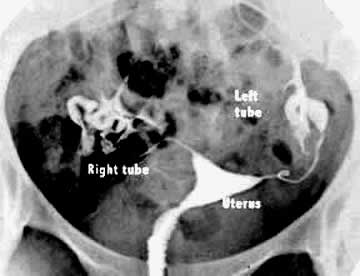What is Hysterosalpingography Examination?
- Hysterosalpingography / HSG is an examination to visualise uterus and the fallopian tube.[1]
- The examination is done under fluoroscopy and uses contrast medium to visualise the uterus and fallopian tube more clearly. [2]
- The Radiologist will be able to have a complete view overall view of the reproductive system when the contrast medium is flows through and fills the fallopian tubes. Blockage of the fallopian tubes and abnormal structures will be shown.
- The examination is performed by a radiologist and assisted by a female radiographer and a nurse.
Picture 1: Structures involved in HSG
Source: www.google.com/url?
Picture 2: Normal HSG
Source: www.google.com/search?q=hysterosalpingogram
Reasons For HSG
- Infertility (inability to conceive).
- To checked for blocked fallopian tubes and identify abnormal structure of the uterus and reproductive system.
- Frequent abortion.
- Follow-up for certain surgical procedures. (refer Hysterosalpingogram)
HSG is also be done to determine whether surgery of the fallopian tubes or or tubal ligation is successful.
How Can I Get This Examination Done And Where?
- The doctor you are seeing will decide if you need the examination.
- If necessary, the doctor will make a request for examination using Request Form For Radiological Examination.
- This examination is available in selected Ministry of Health hospitals.
Preparation For HSG Procedures
- The appointment date for the examination will be given between the 4th to the 10th day from the first day of your menstrual period (refer LMP).
- This is important to ensure that you are not pregnant and to reduce the risk of infection. Please discuss with your doctor if there is a possibility that you may be pregnant.
- You need to contact the Radiology department for an appointment date on the first day of your menstrual period. This is to enable the department to fix a suitable date.
- You do not have to fast, but are advised not to take a heavy meal before HSG examination.
- You should inform the doctor if you have previous history of asthma, allergies to seafood, drugs and contrast media. This is to reduce the risk of adverse reaction from the use of contrast media during the examination.
- You may be given a pain killer (paracetamol) an hour before the examination.
- You are not allowed / not encouraged to have intercourse without using a contraceptive device to avoid being pregnant at the time of the examination.
Before examination
- You will be asked about your preparation for the HSG.
- Please inform the radiographer if you are pregnant or may be pregnant.
- The radiographer will explain the procedure.
- You will need to change into a hospital gown that will be provided.
During examination
- You will be asked to lie down on the examination table in the lithotomy position (similar to the position for childbirth).
- The doctor will clean your cervix using a special fluid.
- A tube will be inserted into the cervix.
- Then, you can straighten your legs and will be positioned by the radiographer.
- Contrast medium will be injected through the tube and the images are captured.
After examination
- After the HSG examination, you may feel slight cramps, nausea or dizziness, but this is usually temporary.
- There may be slight bleeding in the vagina, and contrast injected during the procedure may flow out. You are advised to use a sanitary pad for 1 or 2 days.
- The doctor may prescribe an antibiotic (if necessary). [4]
Please See Your Doctor Immediately If
- You feel increasing pain in the lower abdomen or pelvic area.
- There are signs of infection such as headache, muscle ache, dizziness and fever.
- There is a continuous bleed from the vagina.
- There is continuous and abnormal vaginal discharge. (refer Hysterosalpingography)
Examination Report
- Images acquired during the examination will be viewed by a radiologist who will then report the examination.
Privacy
- The department will ensure your privacy throughout the examination.
References
- http://en.wikipedia.org/wiki/Hysterosalpingography
- http://www.webmd.com/infertility-and-reproduction/guide/hysterosalpingogram-21590
- http://www.healthline.com/health/hysterosalpingography
- http://www.nlm.nih.gov/medlineplus/ency/article/003404.htm
| Last Reviewed | : | 5 January 2017 |
| Translator | : | Daud bin Ismail |
| Accreditor | : | Irene Tong Lee Kew |









